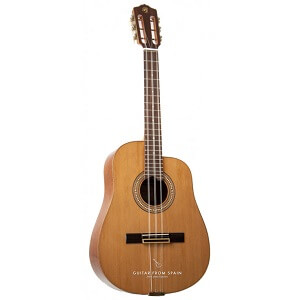Tres Cubano
 The tres cubano is a plucked box-lute chordophone of Cuba that is derived from the European guitar. Similar guitars are found elsewhere in the Caribbean, especially in the Dominican Republic and Puerto Rico, differing somewhat from the tres cubano in their tuning and resonator shape. Primarily an ensemble rather than solo instrument, it is found in groups accompanying Cuban popular dance styles, most notably the son, and regional song forms (punto cubano).
The tres cubano is a plucked box-lute chordophone of Cuba that is derived from the European guitar. Similar guitars are found elsewhere in the Caribbean, especially in the Dominican Republic and Puerto Rico, differing somewhat from the tres cubano in their tuning and resonator shape. Primarily an ensemble rather than solo instrument, it is found in groups accompanying Cuban popular dance styles, most notably the son, and regional song forms (punto cubano).
The resonator of this tres cubano is constructed from thinly-shaven boards of wood--mahogany for the sides and back, and western red cedar for the soundboard. On the interior sides of the back and soundboard a number of wooden struts are glued before the boards themselves are glued to the side. These strengthen the boards structurally and enhance their resonance. The flat soundboard has a circular soundhole cut in it near the center of its top half, and a wooden pressure bridge with a bone saddle is glued to the soundboard approximately in the middle of its lower half. The neck and peg block are fabricated from a single block of mahogany. The neck and resonator are securely joined in the Spanish style, which basically involves conjoining the resonator sides with the foot of the neck and then gluing the foot to the inside faces of the soundboard and back. The topside of the neck is laminated with a flat fingerboard of rosewood that has 18 metal frets inserted into grooves cut across it. The top end of the fingerboard terminates at a nut (a raised ridge) made of bone, but the first fret, located just a fraction of an inch below it, actually functions as the nut, leaving 17 frets for stopping the strings. The fingerboard overlaps the soundboard at the eleventh fret and continues up to the edge of the soundhole. The pegblock is slotted and has two sets of three lateral-mounted metal machine heads with back-facing knobs. Three double courses of wire strings (the second from the left in the image being the only wound one), are tied to the edge of a metal tailpiece, make contact with the bone saddle on the bridge, then run over and slightly above the soundboard and the fretted fingerboard before making contact with the top-most fret and the nut and being wound around the tuning peg capstans. The strings all have the same vibrating length of 21 inches as measured from the bridge saddle to the first fret.